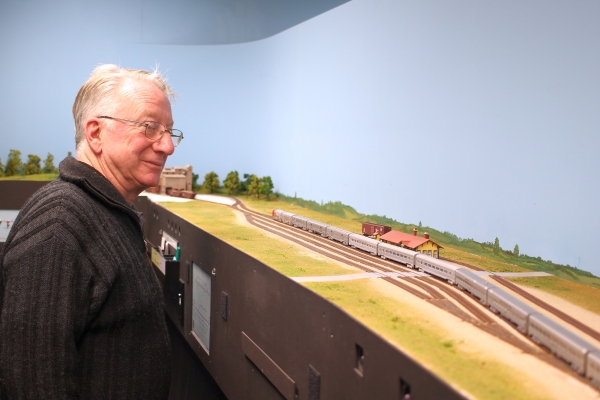A few weeks ago I bought a cordless/rechargeable airbrush and compressor combination device, and over the past days I've been trying it out. I initially thought that it might be useful for painting track, and that is what I've been using it for.
About a year ago I used my ancient Badger single-action airbrush and Tamiya acrylic (XF) paint to paint the track at Pauls Valley. The Badger did a great job, but the wide spray pattern used a lot of paint, and the long air-hose was a PITA to work around. So I was keen to see how this "hose-less" device would go.
My first attempt (last Friday) didn't go as well as I was hoping, but that was mainly due to my inexperience with both the airbrush and the acrylic paint. I thinned the paint to about the same consistency that I'd used to paint the track at Pauls Valley with my Badger, but I failed to consider that I would be using a lower air pressure with this new airbrush.
The job started well, but about one-quarter of the way through, the nozzle started to give me trouble due to paint clogging. I ran some thinner through it, and thinned the paint more. But performance continued to get worse, with less and less paint being sprayed. Then, when I was about 90% done, the compressor battery died. I gave the airbrush a thorough clean, put the compressor on charge, and then walked away.
Today I took another look at the work and decided that due to the thinness of the paint it would need a second coat. I decided to try the airbrush/compressor unit again, but this time I did the job correctly, and thinned the paint 2 parts thinner to 1 part paint.
WOW! What a difference that made.
It took me only about 15 minutes to repaint the track, and at the end I simply ran a few loads of cleaner through the airbrush to clean it up ready for the next job.
On the down side - my combo only operates at a low(ish) pressure (claimed 17 psi and 7 litres/min), so I can't blast large volumes of paint through it as I might if I used my other compressor with a higher pressure setting. And even though the airbrush itself is a dual-action model, it attaches to the compressor without using the air-flow valve, so I can't control the flow of air using the trigger.
Despite those shortcomings I like this device. It's a great bit of kit for working away from an airbrush station, or if (like me) you don't have an airbrush station, or you want to be able to work without disturbing your family.
Would I buy this again?
Well, yes ... and maybe no - possibly not this particular unit, anyway. Since I bought mine the price has gone up about $20 from the same seller, and in the meantime I've found another unit that, for nearly double the price I paid, has a switch that provides a choice of two air pressure settings, and that allows the airflow to be controlled via a valve (in the normal dual-action way.) I would be tempted to try one of those next time.
This is the unit that I bought:
There are many videos on Youtube reviewing these combination units. If you're interested in getting one yourself I recommend that you spend some time watching a few of them. This is the one that got me started:
https://www.youtube.com/watch?v=DhVkJTHkWRQ
Regards,
Ron






































